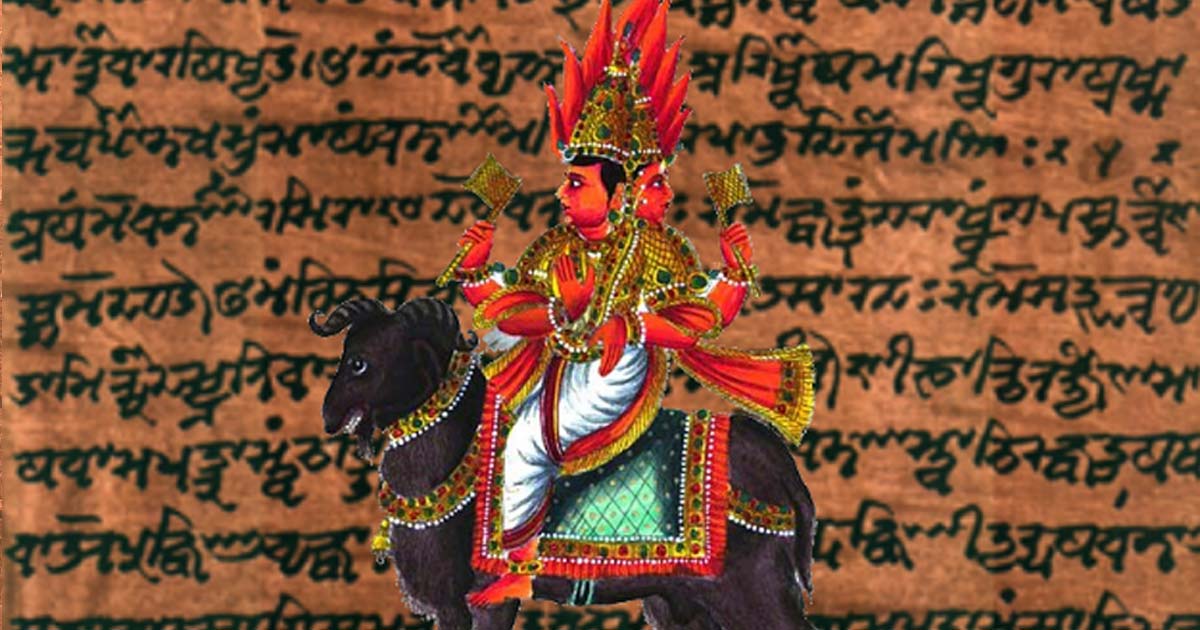The Atharva Veda: Popular Religion, Charms, and Ancient Hindu Spells
Thou who art neither alive nor dead, the immortal child of the gods art thou, O Sleep! Varunânî is thy mother, Yama (death) thy father, Araru is thy name. We know, O Sleep, thy birth, thou art the son of the divine women-folk, the instrument of Yama (death)! Thou art the ender, thou art death! Thus do we know thee, O Sleep: do thou, O Sleep, protect us from evil dreams! As one pays off a sixteenth, an eighth, or an (entire) debt, thus do we transfer every evil dream upon our enemy.
-Hymn VI, 46. Exorcism of evil dreams. The Atharva Veda
The Atharva Veda is one of the four Vedas, the other three being the Rig Veda, the Sama Veda, and the Yajur Veda. The Vedas are the sacred scriptures of Hinduism and are believed to have been composed in India between 1500 BC and the end of the 1st millennium BC.
The Vedas may be considered as knowledge texts (the word ‘veda’ itself has been translated to mean ‘knowledge’), and, generally speaking, there is a strong priestly bias to them, as the Brahmins monopolized the production and the transmission of these texts. The Atharva Veda itself has been translated to mean the ‘Veda of Magic Formulas’, though not all scholars agree with this translation. Nevertheless, compared to the other three Vedas, the Atharva Veda seems to represent ‘popular religion’, as its charms and incantations are more folkloric in nature.
- The Vedas: Ancient Mystical Texts Offer Charms, Incantations, Mythological Accounts and Formulas for Enlightenment
- The Anu and Ancient Seers in the Rig Veda
- Saraswati: Hindu Goddess of Aesthetics and Protector of the Universe
Writing the Atharva Veda
The Atharva Veda is named after the legendary Vedic sage Atharvan, who is believed to have ‘heard’ this Veda, and then had it written down. Atharvan is called one of the Saptarishi, or seven seers, and is believed to have instituted the fire sacrifice. Additionally, some have claimed that Atharvan means ‘fire priest’. The Atharva Veda is also known as the Atharvangirasa Veda, which attributes this sacred text to Atharvan and Angira, another Hindu sage. Compared to the other Vedas, the Atharva Veda was composed at a later date, perhaps as late as 500 BC.
The Atharva Veda is divided into 20 kandas (equivalent to books), which contains a total of 730 suktas (meaning ‘hymns’). In total, the Atharva Veda has about 6000 mantras (meaning ‘verses’), most of which are metrical. It may be noted, however, that a small number of hymns, estimated to be about a sixth of the entire Atharva Veda, were written in prose.

Codex Cashmiriensis folio 187a from Atharva-Veda Saṁhitā second half, by William Dwight Whitney and Charles Rockwell Lanman. (Public Domain)
The Nature of the Atharva Veda Mantras
The Atharva Veda has been described as the ‘Veda of varied knowledge’, as it deals with numerous subject matters. These may be divided into three main categories. The first of these related to the curing of diseases, and the destruction of adverse forces.
For example, in Book I, there are several charms against fever, a few charms against poison, and charms against worms (for oneself / for one’s cattle / for one’s children). There are also charms that were meant to combat spiritual, rather than physical illnesses. These include charms against possession by demons of disease, and charms for driving away demons. Furthermore, there are charms meant to protect a person against malicious adversaries, such as sorcerers, and ‘enemies thwarting holy work’.
- Speakers at Science Congress says ancient India mastered advanced space flight thousands of years ago
- Ayurvedic Medicine: A Traditional Knowledge of Life from India that Has Endured the Passage of Time
- Ancient Text Prescribing Ways to Conceive a Baby Boy Included in New University Textbook in India
The second category consists of hymns related to everyday life, such as health, wealth, friendship, and marriage. Examples of hymns that fall in this category include charms for a woman to obtain a husband, a charm to promote virility (incidentally, there is also a charm to deprive a man of his virility), and a charm to secure perfect health.
The third category of hymns pertain higher matters, such as the nature of the Supreme Being, immortality, and time. Examples include the ‘Hymn to goddess Earth’, and the ‘Glorification of the sun, or the primeval principle, as a Brahman disciple’.

A steel engraving from the 1850s, which depicts the creative activities of Prajapati, a Vedic deity who presides over procreation and protection of life. (Public Domain)
A Peek into Daily Life in the Vedic Period
About 20 percent of this text (equivalent to about 1200 verses) is found to overlap with the Rig Veda. Nevertheless, the rest of the verses are unique to this book and provide a representation of the concerns that the common man during the Vedic period had in his day to day life. Thus, the Atharva Veda has been considered to be a representation of ‘popular religion’, as opposed to the ‘hieratic religion’ as seen in the other three Vedas, and it is in this respect that the Atharva Veda may be considered to be an important source of information for our understanding of the Vedic period.
Top Image: Agni, a deity which appears in the Atharva Veda. (Public Domain) Background: Detail of Codex Cashmiriensis folio 187a from Atharva-Veda Saṁhitā second half, by William Dwight Whitney and Charles Rockwell Lanman. (Public Domain)
By Wu Mingren
References
Bloomfield, M. (trans.), 1897. Hymns of the Atharva-Veda. [Online]
Available at: http://www.sacred-texts.com/hin/av.htm
Dhwty, 2017. The Vedas: Ancient Mystical Texts Offer Charms, Incantations, Mythological Accounts and Formulas for Enlightenment. [Online]
Available at: http://www.ancient-origins.net/artifacts-ancient-writings/vedas-ancient-mystical-texts-offer-charms-incantations-mythological-021161
ReligionFacts.com, 2017. Atharva Veda. [Online]
Available at: http://www.religionfacts.com/atharva-veda
Sharma, Y., 2015. Rishi Astika and Rishi Atharvan. [Online]
Available at: https://www.speakingtree.in/blog/rishi-astika-and-rishi-atharvan
Singh, S. P., 2018. Introduction to Atharva Veda. [Online]
Available at: http://themodernvedic.com/mythology/atharva-veda/
vedicheritage.gov.in, 2018. Atharvaveda. [Online]
Available at: http://vedicheritage.gov.in/samhitas/atharvaveda-samhitas/

















